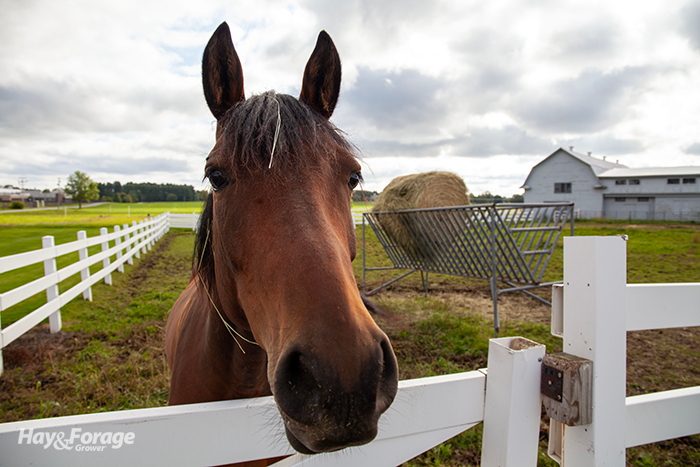
Horse hay has its own set of standards that are exclusive to equine. Many of these standards fall under the physical attributes of the bale, followed by the nutritive qualities of the forage, but clean and green hay is usually a priority. So, is there a best type of horse hay that checks all the boxes?
In a recent issue of the Midwest Forage Association’s Forage Focus newsletter, Kevin Sedivec with North Dakota State University Extension says cool-season grass hay is usually a great choice. The rangeland management specialist explains that many grass species can provide adequate fiber and energy to ensure a healthy gut microbiome and metabolism, as long as forage is harvested on time.
“Grass hay should be cut just past the boot stage when heads start to emerge to optimize quality and quantity,” Sedivec writes. “When you inspect the hay, seedheads should be low in quantity.”
Orchardgrass, timothy, meadow bromegrass, and smooth bromegrass are all good candidates for Midwestern horse hay, Sedivec says. He warns that even though wheatgrasses can make quality hay when cut in the boot stage, this hay can easily become rank if harvest is delayed. And even though Kentucky bluegrass can be a good grass to graze, it matures earlier than other horse-type grasses and is more likely to be cut too late in maturity.
“I usually look for bromegrass and orchardgrass hay since horses love them and they provide good nutrition for most leisure horses,” Sedivec states. “Timothy is also a great hay if it is harvested before seedheads emerge.”
Alfalfa hay is another option; however, Sedivec says it is typically more expensive and higher quality than what most horses need. Considering the protein and energy content in good-quality alfalfa, it may be practical for lactating mares, growing horses, and performance animals, but horses can be selective of lower quality alfalfa.
“One major downfall with alfalfa is when it is harvested mature, it becomes stemmy and horses tend to pick the leaves and leave the stems,” Sedivec says. “Some horses — especially older horses — can founder from alfalfa, especially if it is really leafy.”
With that said, supplementing a grass hay diet with good-quality alfalfa hay can be a win-win solution if both types are available.
No weeds, dust, or mold
Regardless of hay type, the best forage for horses must be free of weeds, mold, and dust. Sedivec says weeds can be unpalatable, toxic, or painful to eat. Awns from weed seedheads particularly cause discomfort and can become lodged in horses’ gums. Sedivec adds that blister beetles are another pest that can plague hay, though they are more common in alfalfa hay than grass hay.
Inspect hay for unpalatable weeds or unwanted materials such as pigweeds, burdock, thistles, and twigs. “Horses will refuse to eat pigeon grass, foxtail barley, and mature and stemmy grasses, which is usually a sign the hay was harvested at a mature stage, and thus is low in palatability,” Sedivec writes.
Search for toxic plants like hoary alyssum, buttercup, and common ragwort as well. Be cautious of hay from wet meadows that may contain water hemlock. And beware of hay from fields bordered by maple trees as these leaves can be toxic to horses.
Do not feed horses hay that is moldy. Mold can cause colic, respiratory issues, abortion, and in extreme cases, death. It can also cause hay to become dusty — another attribute to avoid.
Sedivec says all hay types are usually deficient in some vitamins and minerals that are necessary for horses, but especially hay that is made in the Midwest. “Plants are always extremely low in sodium,” he writes. “Grasses tend to be deficient in phosphorus, and all hay types in our region are low in copper and zinc in most years. Always provide salt and minerals to your animals.”

